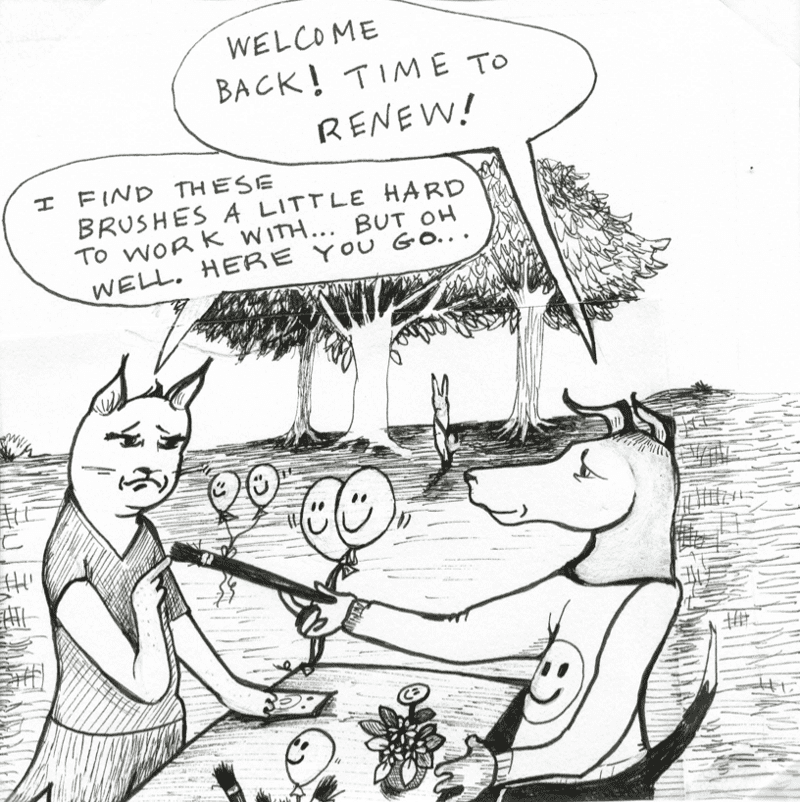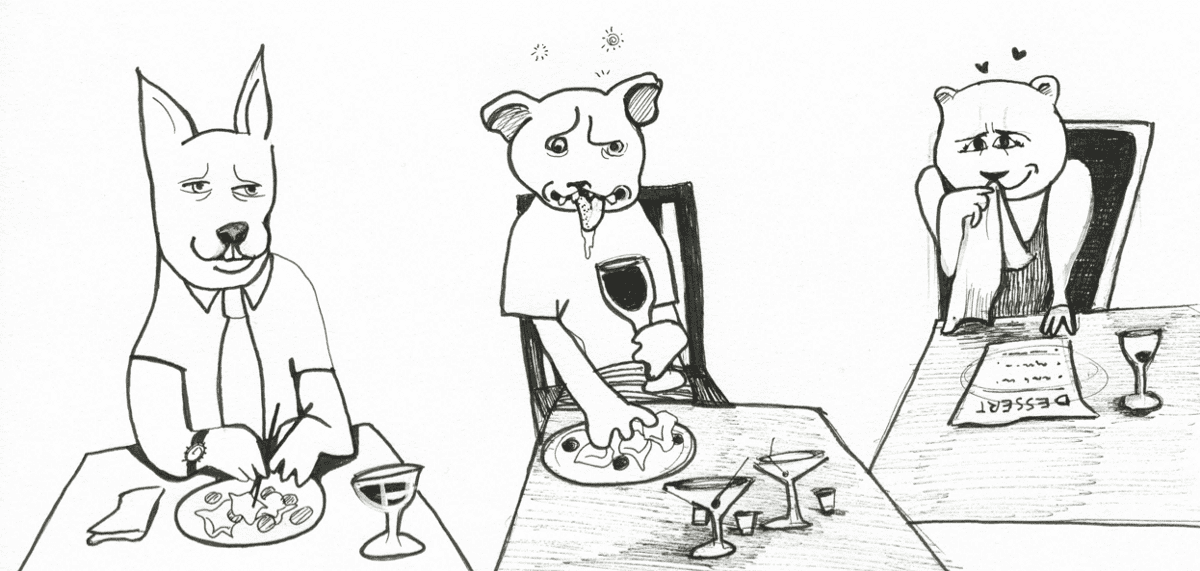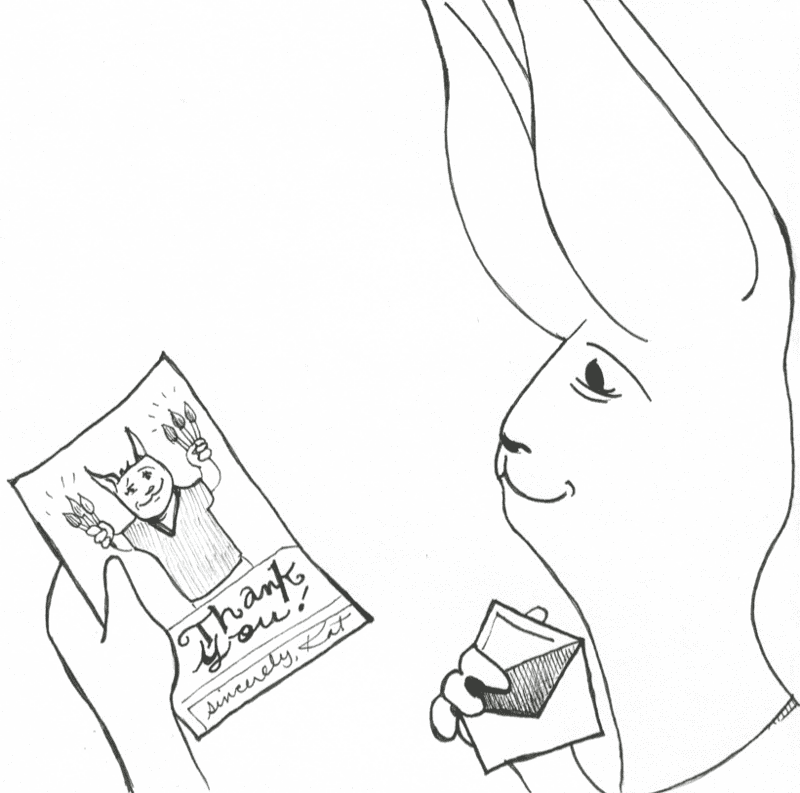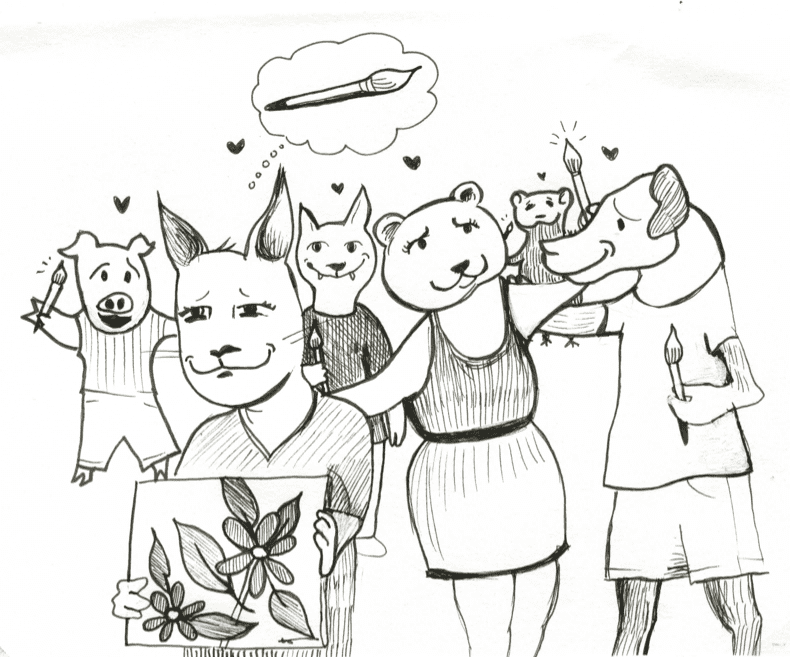Drawings by Claire Bowman
How delighted customers behave, and why measuring and learning from these signals is likely one of the most important things you can do for your product
Yes … Delight
Rewind to a time before, as Kevin Roose writes in New York Magazine, “the titans of tech start[ed] talking like kindergarten teachers.” Delight meant a high degree of satisfaction … the 10 on a 1–10 custom satisfaction survey.* *Fast-forward and it has come to represent all that is wrong with gratuitous design-for-design’s-sake, startup founder-speak/gibberish, and hokey marketing campaigns.
Jared Spool beautifully describes the difference in this story about Hyatt Hotels and their “random acts of kindness” campaign:
The problem at the time, and the reason their customer satisfaction was going down, was that they had a lot of frustraters to combat. They were getting a large number of complaints. Instead of addressing those problems they decided to go for delight and focus on delighting people. [They thought] hopefully you can use delight to cover the bad smell of the failing hotelThat’s not the brand of delight I’m talking about in this post. I’d like to resurrect the classic, more general definition … because delighted means extremely satisfied or pleased. And this post is about what customers do when they are extremely satisfied or pleased.
Plus delight is 10 characters less than extremely satisfied. Onward …
The Product/Market Fitting Room
Start-ups constantly struggle with defining (and finding) product/market fit. They plumb product metrics hoping to “prove” engagement and predict renewals. From a strict dollars-and-cents standpoint, selling product and renewing customers is the goal. But, in most domains (and especially B2B SaaS), neither really indicates whether the customer is truly delighted with their purchase.
Many businesses make the mistake of assuming that a customer is loyal, simply because they aren’t complaining and they keep coming back month after month. -
Wootric, “What Happens When You Confuse Repeat Business with Customer Loyalty”
 Users with a “meh” attitude toward the product often stick around — sometimes because they don’t have the time or energy to shop around, sometimes because they’re too embarrassed to admit to themselves that they purchased the wrong tool, and sometimes because someone is forcing them to use the software
Users with a “meh” attitude toward the product often stick around — sometimes because they don’t have the time or energy to shop around, sometimes because they’re too embarrassed to admit to themselves that they purchased the wrong tool, and sometimes because someone is forcing them to use the software
.
From “Meh” to “No, Thanks”
The trouble is that this customer indifference comes back to haunt you. That captive user leaves their company and becomes a buyer elsewhere. As your company grows, your time to sweet-talk individual customers into sticking around is reduced.
 You start rationalizing by thinking that usability and delighting customers aren’t important in your domain, and that you’ll be fine as long as the economics look promising. Maybe you cobble together some white papers and share the occasional success story. Or, you fetishize using customer support, customer success, and services
You start rationalizing by thinking that usability and delighting customers aren’t important in your domain, and that you’ll be fine as long as the economics look promising. Maybe you cobble together some white papers and share the occasional success story. Or, you fetishize using customer support, customer success, and services
to patch up holes in your product. Mediocre becomes the new normal.
This all takes a toll: your team eventually becomes disengaged. The product rots from the inside out. Turning back the clock and regaining your edge is a daunting task. You either start and stay there, or fight an uphill battle to find your lost (or maybe never explored) product mojo.
There is a way around this, but it requires stubbornness and bullheadedness: Demand to see evidence of real customer delight minus the Kool-Aid.
“Measure” and Observe Delight
I’m going to go out on a very un-data-nerd-like limb here. To truly delight your customers and create an amazing, differentiated product (and to do so consistently year after year), you’ll need to measure things a bit differently. I say this as someone who spends a great deal of time worrying about how to measure things and how to use descriptive, predictive, and prescriptive analytics to improve my product.
I’d argue that many of the product metrics we capture (e.g. engagement, conversions) are proxies for less tangible things like customer delight, advocacy, and product focus. The hard metrics can be used to predict churn and trial conversions, but they fail to cut at the central question: Is our product truly inspiring our customers and kicking ass? And, if so, why? Are we In-N-Out Burger, or McDonalds?
Consider an example: a not-too-impressed diner leaves a 15% tip. A drunk diner leaves a 20% tip. A thoroughly impressed and new fan-for-life diner leaves a 20% tip. All give the restaurant four stars in their online reviews. How do you differentiate rabid foodie fandom from “a decent meal” or a happy buzz?
 Not-Too-Impressed, Drunk, or Fan?You can do a sentiment analysis of the review. Factor in the tip. Record facial biometrics
Not-Too-Impressed, Drunk, or Fan?You can do a sentiment analysis of the review. Factor in the tip. Record facial biometrics
. Have the server assess the diner satisfaction. Measure length of the dining experience.
It is all “data,” albeit largely qualitative. The human computer is a pretty good pattern matcher and sensor (despite our various biases, or maybe because of them). We lost at Go vs. Google, but we are not half-bad at detecting rampant excitement. If it was all down to a perfect science, though, we’d consistently make great products, predict all trends, convert all customers, and never have product fails.
Why Measure/Look For Delight?
When we open our eyes to what customer delight looks and feels like, we get the right signals to tune our product strategy. By product here I’m talking about the the whole package: who you target, how you make customers successful (customer success), the goals and outcomes your software supports, your support team, and your sales team. From the service design perspective, every interaction you have with customers is “the product.” The customer experience extends far beyond logging into a tool each day.
The key is awareness and not rationalizing a tepid response. When you have that awareness of what a happy customer truly looks like, the rest becomes “easy” (but still damn hard). For the builders it becomes more fun and rewarding. And that has to count for something.
The Delighted Customer
So, what do you keep your eyes open for? Take a big step back from your dashboards, spreadsheets, and predictive algorithms and ask if your users/customers are truly delighted. Are they obsessed with your product? Do they self-identify with your mission? Are they your sales team, marketing department, and product idea box all wrapped into one? And not just one customer, or the occasional success story, but a good swath of your customers?
It is easy to pretend this stuff is happening. Or rationalize that it doesn’t matter. But when it really happens, it’s a awesome thing. If you pay attention, you may notice that the delighted customer…
1. Really Likes You
- Bakes the team a cake. (This is not a joke — I’ve seen it happen!)
- Visits you when they’re in town. Invites you out for drinks.
- Remembers your name! And the names of your team members.
- Bugs you for T-shirts. And then sends you a photo of them wearing the T-shirt.
- Uses emoticons when writing otherwise dry emails. Like …
2. While in the Buying Process…
- Seeks you out prior to purchase! Is delighted by what they imagine they can do with your product. Your marketing just gets them more excited. On that first call, is bubbling with ideas and questions before you even get started.
- Shows hints of delight right from the start. Dives into a trial and take things further than you ever expected. On some level you feel like the roles have been reversed, and they’re selling to you!
- Already knows how you compare to the competition — they’ve done their homework.
- Can describe the precise pain they hope to address, or goal they hope to achieve, and connect that to unique product traits.
- Makes the internal renewal case for you and spearheads the discussion with purchasing
- Contacts you to renew, instead of waiting for your call. Contacts you to explore purchasing add-ons, instead of waiting for your email.
- A couple of months after purchasing, writes to thank you. Literally, as in a handwritten thank-you note.

3. While Using the Product…
 * Describes your product as “very easy to use,” ”easy to learn,” ”user-friendly.” Cliche, yes, but NPS and SUS (system usability score) are related (more on this here). This you can measure quantitatively.
* Describes your product as “very easy to use,” ”easy to learn,” ”user-friendly.” Cliche, yes, but NPS and SUS (system usability score) are related (more on this here). This you can measure quantitatively.
- Uses your product/company name as a verb: “We ______ed it.”
- Writes you unsolicited emails with feature/product *ideas* (not feature requests, or fixes for workarounds).
- Sends you feedback on new features shortly after they are released, again, without prompting.
- Invests money to integrate with your product. Many customers may ask for pre-built “connectors,” but the most passionate customers will find it worth it to shoulder the cost of integrating.
- Does awesome and unexpected things with your product (things you never expected or planned for).

 * Hounds you to learn about the roadmap, not because they’re waiting on features, but rather because they want to plan their training and get the most out of new functionality.
* Hounds you to learn about the roadmap, not because they’re waiting on features, but rather because they want to plan their training and get the most out of new functionality. - Regularly seeks the help of your support team to resolve their challenges rather than challenges with your product. The difference is critical.
4. For Things They Value…
- Writes or calls you to describe wins and provide proof (qualitative and quantitative data).
- Describes how your product is actually changing the way they work and explains how.
- Credits you for making their *personal* job easier and more effective. Or better yet, for helping them get a raise!
- Proposes interesting partnerships if your products share a similar domain.
- Creates their own training material around your product — not because your help docs aren’t comprehensive, but because they’re morphing their company around your product.
5. As an Advocate…
See this post for more about the value of brand advocacy.
 * Hounds you to be part of a beta group or research panel.
* Hounds you to be part of a beta group or research panel.
- Refers you to friends and professional contacts in their industry.
- Uses because when describing why they love your product: “I love ____ because.” Your best customer advocate is someone who can explain why the product benefits them.
- Brings you with them to their next job, or at least tries.
- Sends you unsolicited ideas for white papers and case studies. Volunteers because they want to be associated with the product. Provides you a reference logo for your website without prompting.
- Interact with you across all available channels (blog post comments, forums, etc.).
- Without coercion, recommends your product on sites like Quora, Stack Overflow, etc., and includes a detailed explanation of the “why.”
- Hounds you about having a user conference, and maybe even offers to host one.
- Promotes your product across their organization. Suddenly you get calls from people you’ve never met and they are already sold on the product because “_______ has been singing your praises.”
Conclusion
This is not an argument against being data-driven. Rather, it’s an argument for widening the information gathering net. I speak with many product teams. They describe the glory days of being able to talk to each customer, to fill their backlog with valuable items, and to ship software effortlessly. But now “things are complicated”, budgets are tighter, and there’s a pressure to show the ROI for product development efforts. Sure, build your analytics chops. Use whatever data — quantitative and qualitative — you can find. Predict, prescribe, and describe.
But don’t forget what got you here in the first place: happy, engaged, and yes delighted customers. Because in most cases the metrics will bring you back there anyway. Lay off the Koolaid and start listening.

